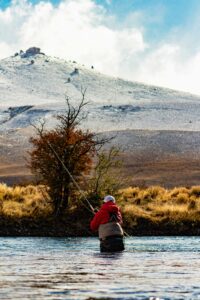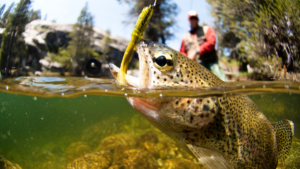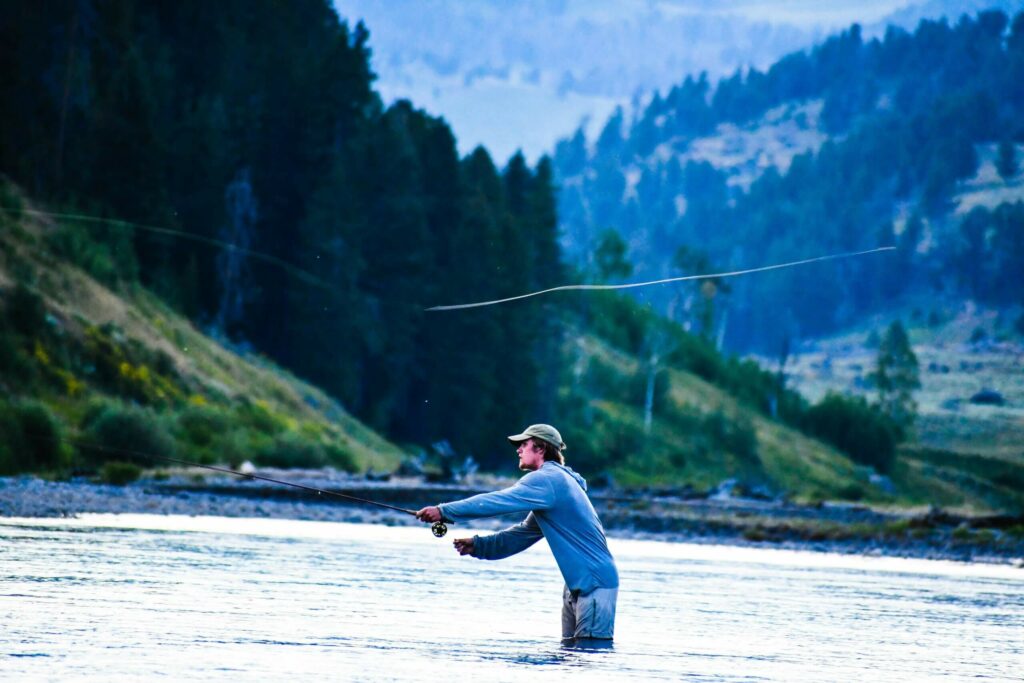Fishing can be polarizing, with people either loving it or not. Those who dislike it often call it boring, brainless, and smelly—though they’ve likely never tried fly fishing. Unlike traditional fishing, fly fishing is active, requires skill and knowledge, and offers no guarantee of success. Catching something is a rewarding accomplishment that combines perfect fly selection, placement, and drift. It’s challenging, addictive, and takes you to incredible places, motivating you to get outside, be active, and have fun. Fly fishing is also a more refined, artistic form of angling that allows you to explore new, exciting locations. If you’re seeking a more action-oriented version of fishing, fly fishing may be just what you’re looking for.

Immerse in the environment while fishing
What Is Fly Fishing?
Fly fishing is a unique form of angling where artificial flies, designed to mimic natural insects or baitfish, are used to catch fish. Unlike traditional fishing, fly fishing requires specialized gear, including a long, lightweight rod, a weighted line, and a transparent leader. The fly, being almost weightless, is cast using a technique that involves false casting—repeatedly casting back and forth to let out more line until the fly reaches the target area without the fish seeing the line.
This method demands refined skills and a deep connection with nature, making it more than just a sport—it’s an art form. Fly fishing is practiced in both freshwater and saltwater, with freshwater fishing typically divided into cold-water and warm-water species. Fly fishermen often use lighter setups and smaller flies compared to other anglers. The focus is on conservation, with many fly fishermen practicing catch-and-release to preserve fish populations and waterways.
Key Components of Fly Fishing:
-
Fly Rod:
-
A longer, more flexible rod compared to traditional fishing rods. The length and flexibility allow for delicate casting and precise presentation of the fly.
-
-
Fly Reel:
-
The reel stores the fishing line and allows you to control the amount of line released. It’s important for managing the line during a fish’s run.
-
-
Fly Line:
-
Unlike regular fishing lines, fly lines are thicker and heavier to help carry the lightweight fly through the air. The weight and thickness of the line vary depending on the type of fish you’re targeting and the conditions of the water.
-
-
Leader Line and Tippet:
-
The leader is a length of clear, strong line that connects the fly line to the fly. The tippet is a thinner section at the end of the leader, designed to be nearly invisible to fish.
-
-
The Fly:
-
The fly is an artificial bait made from various materials like feathers, fur, thread, and beads, designed to mimic real-life aquatic creatures (like insects, small fish, or crustaceans). Flies are divided into categories:
-

Your handy fly reel and fly rod
What Are the Different Types of Flies?
In fly fishing, “flies” are artificial lures designed to imitate a wide variety of aquatic prey, such as insects, small fish, and other food sources that fish eat. The creation of these flies, known as “fly tying,” involves using materials like feathers, threads, and synthetic fibers. While non-anglers may think of houseflies, in fly fishing, “flies” refer to any artificial bait that uses thread to attach materials to a hook and can be cast with a fly rod.
There are countless fly patterns, each designed to mimic specific prey, and every fly pattern has its own unique combination of materials and tying technique. For example, the Parachute Adams is a well-known pattern. The versatility of flies, with no limit to what they can imitate, allows anglers to match whatever a fish is feeding on. While the vast number of patterns can be overwhelming, we’ll break them down into categories for simplicity:
- Dry flies:
- Float on the water’s surface, imitating insects that land on the water.
- Nymphs:
- Subsurface flies that imitate the immature stages of insects living underwater.
- Streamers:
- Larger flies that imitate baitfish or other larger creatures.
- Wet flies:
- Submerged flies that mimic insects moving through the water.
What Are Some Fly Fishing Techniques?
Fishing with artificial flies requires greater skill and finesse than traditional bait fishing. Unlike bait fishing, where the lure’s weight does most of the work, fly anglers must master the delicate art of casting, using precise movements to direct the fly line and fly to the target. This technique, which emphasizes precision over strength, adds challenge and excitement to the sport, making each successful cast and hook set especially rewarding. Mastery comes with practice, and improving your casting skills can be achieved by practicing in open areas or joining local fly fishing groups and workshops to learn from experienced anglers.
-
Casting:
-
Fly fishing involves unique casting techniques like the overhead cast or roll cast, where the fly line is propelled through the air, and the fly lands gently on the water. This is done with careful control to avoid tangling and spooking the fish.
-
-
Drift:
-
Once the fly lands on the water, it must “drift” naturally, mimicking the movement of real insects or prey in the current. This is often where fly anglers spend a lot of their time — allowing the fly to move with the current, imitating a natural behavior.
-
- Setting the Hook:
-
When a fish bites the fly, the angler must quickly “set” the hook by pulling the rod upward to embed the hook in the fish’s mouth.
-
Why Do People Choose Fly Fishing?
As you enter the water, a sense of magic emerges, with the rhythmic motion of the fly rod becoming a calming, almost meditative dance. The process of casting, waiting for that elusive tug, and gently releasing each catch brings about a peaceful, zen-like state of mind. Fly fishing is not just about catching fish; it’s about finding tranquility and connecting with nature with each cast. The main reasons people choose fly fishing:
-
Connection with Nature:
-
Fly fishing is often seen as a more immersive and meditative experience. It involves a deep connection with the environment, focusing on water, weather, and natural patterns.
-
-
Skill and Technique:
-
It requires a lot of practice to master the casting techniques, and it’s often considered a challenge. Anglers can take great pride in their skill in presenting a fly perfectly to a fish.
-
-
Catch and Release:
-
Fly fishing is often practiced as a catch-and-release sport, where fish are returned to the water after being caught. This promotes conservation and helps maintain fish populations.
-

General law: Catch and release.
What Types of Fish Are Targeted?
Fly fishing is primarily used to catch species that feed on insects and smaller aquatic creatures. Common fish targeted by fly fishermen include:
-
Trout (Rainbow, Brown, Cutthroat, etc.)
-
Salmon
-
Bass (Smallmouth, Largemouth)
-
Pike
-
Bonefish and Tarpon (for saltwater fly fishing)
Where Can You Fly Fish in the US?
The United States offers numerous prime locations for fly fishing, with many diverse environments and species to target. Here are some top spots:
-
Montana
-
Madison River: Known for its consistent fishing and beautiful surroundings.
-
Bighorn River: Famous for its trophy trout, especially during spring and summer.
-
-
Colorado
-
South Platte River: A top spot for fly fishers, especially around Deckers and Cheesman Canyon.
-
Colorado River: Offering picturesque views and excellent trout fishing.
-
-
Wyoming
-
Snake River: Known for its dramatic scenery and large populations of cutthroat trout.
-
Grey Reef: Famous for its wild rainbow trout and brown trout.
-
-
Alaska
-
Bristol Bay: A world-class destination for salmon and trout fishing.
-
Kenai River: Known for its giant King salmon and rainbow trout.
-
-
California
-
McCloud River: A hidden gem with wild rainbow and brown trout.
-
Eastern Sierra: Popular for its clear waters and excellent opportunities for wild trout
-
These are just a few of the many fly fishing destinations across the country. Whether you’re targeting freshwater species like trout or venturing into saltwater for larger catches like tarpon and bonefish, there’s a spot for every angler.

Trout caught while fly fishing
Fly fishing is a unique and rewarding angling technique that emphasizes skill, precision, and a deep connection with nature. Unlike traditional bait fishing, it involves using a lightweight, artificial fly to mimic the movements of insects and other prey, requiring an intricate casting method that blends artistry with strategy. Beyond the pursuit of fish, fly fishing offers an opportunity for quiet reflection, offering anglers the chance to immerse themselves in the natural world. Whether in tranquil streams or rugged rivers, the experience of fly fishing is as much about the journey and the rhythm of the cast as it is about the catch itself.









